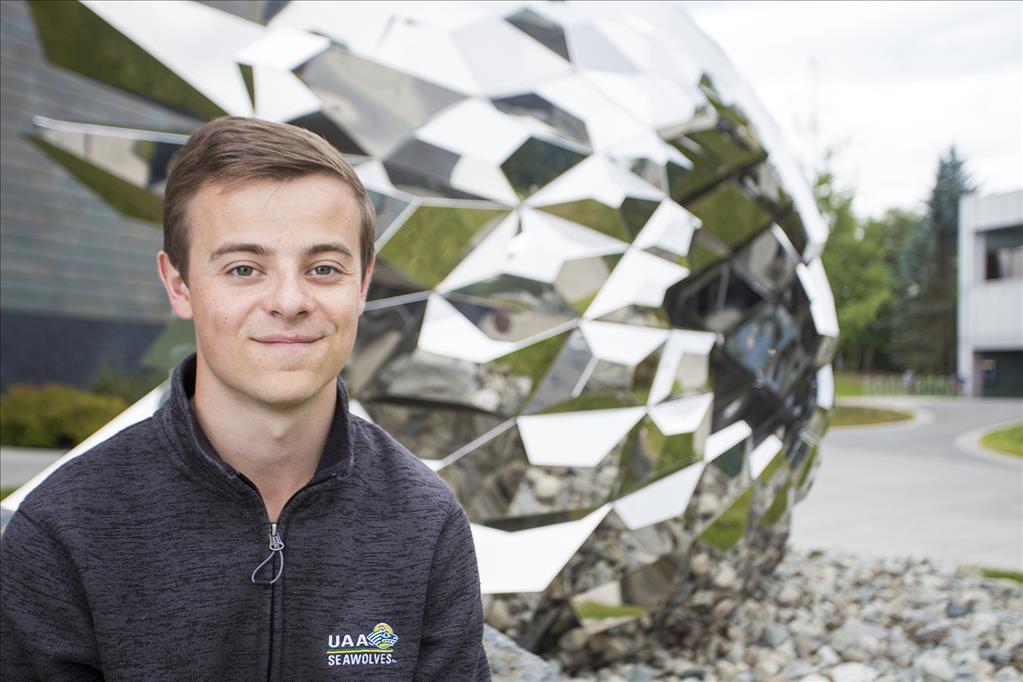Studying homelessness, helping people heal
by Tracy Kalytiak |
How does homelessness happen? There are numerous reasons why people go to the Brother Francis Shelter, a program of Catholic Social Services that provides emergency shelter for men and women in Anchorage who don't have a home.
Perhaps an unexpected medical catastrophe made it impossible to pay a mortgage or rent. Or maybe divorce or death wrecked someone's financial security, casting them adrift.
Guests (and former guests) of the Brother Francis Shelter talked with a UAA graduate researcher probing how and why they became homeless, roles childhood (and current) trauma played in their lives, and factors that impeded or enhanced their resilience and well-being in the context of homelessness.
"I think everyone who did interviews is aware there is a stereotype that homeless people are lazy or have mental issues," said Steffi Marotzke Kim of Rostok, Germany, who is in her second year of work on a Ph.D. in clinical-community psychology at UAA. "But when we talked to people, we were sitting just like we are doing here and they were just expressing how they feel. And they were like, I know my life is not perfect but I'm happy I have a roof over my head, have something to eat, have people I can look after or be there for. It's a different context, but very much like every other person."

Rebecca Robinson, right, and Steffi Kim work together on the "Toward Trauma-Informed Services" project. (Photo by Philip Hall / University of Alaska Anchorage)
UAA Professor Rebecca Robinson is steering the "Toward Trauma-Informed Services" project, which examines well-being and resilience in the Brother Francis Shelter. Two faculty mini-grants from UAA's Center for Community Engagement and Learning are funding the project.
Other grants came from the Society for Community Research and Action, Alaska Native Community Advancement in Psychology (ANCAP) and the Alaska Psychological Association.
"There's lots of literature about marginalization," Robinson said. "If you actually make contact with people who are 'other' than you, very often we realize we aren't really that different, and that's a good way of breaking down stereotypes."
Finding better solutions
Why are Kim and Robinson studying this topic?
Because childhood experiences - both positive and negative - are a key public health issue that influences lifelong health and opportunity.
Researchers with the U.S. Centers for Disease Control and Prevention and Kaiser Permanente (KP) conducted a 1995-1997 study of more than 17,000 adult members of KP's health maintenance organization in Southern California. They performed physical examinations of their subjects and gathered data from them in confidential surveys regarding childhood experiences, present health status and behavior.
Many of these middle-class research subjects, they discovered, had adverse childhood experiences - psychological, physical and sexual abuse, or a household in which there was substance abuse, mental illness, violence or criminal behavior - in their past.
And, the researchers linked a wide array of physical and mental illnesses to these childhood traumas, including substance abuse, mental illness and suicidal thoughts, and chronic conditions like cardiovascular disease, diabetes, cancer and premature death.
"Adverse childhood experiences increase the risk for a range of behavioral and medical conditions," Robinson said. "Shaping systems into trauma-informed systems -responsive to the needs of people with sympathetic nervous systems on overdrive - can potentially increase resilience and well-being."
People who are homeless are particularly susceptible to trauma.
They routinely experience stress because they do not have the security of a locked door between them and people wanting to harm or steal from them; they must find shelter from frigid, life-threatening weather; they might not be sure when or where they'll be able to eat a nourishing meal. That trauma can be even more acute if they are homeless and needing to provide for children or someone who is ill.
Grappling with the aftermath of ACEs compounds the difficulties, making it extremely difficult to cope with challenging circumstances - especially when interacting with shelter staff and others who may misinterpret angry or frustrated outbursts as misbehavior instead of trauma responses.
Researchers hope to produce data the shelter can use to inform policy and programming decisions.
A part of "trauma-informed" care is about promoting resilience through education and training of staff.
"Building a basic understanding of what trauma is and how it plays out through behavior is the first step in developing trauma-informed systems," Robinson said. "Once that understanding is in place, we can look at policies and procedures that are in place and consider whether they help or hinder recovery from trauma. For example, providing shelter staff and guests with easy-to-understand information about trauma prevalence and responses and tips for coping is a trauma-informed policy."
Robinson says she likes to use the so-called "hand model" of the brain to explain trauma to people without specialized knowledge in this area, and illustrate how the brain reacts when faced with danger.
"The frontal cortex essentially 'flips' off line, hence, people seemingly 'flip their lid'," she said. "People with complex trauma histories tend to experience more 'lid flips' due to overactivity of their sympathetic nervous system. When one's lid is flipped, so to speak, their rational mind is off line; they are in a fight-or-flight state of being."
Robinson says that knowledge of the brain can help people communicate more effectively with a person in this "lid-flipped" state.
"For example, this is probably not the time to ask somebody why they are acting the way they are acting," she said. "It is not the time to engage rationally. Rather, it may be time to take a deep breath, take a walk, drink some water. Come back down."
Robinson said shelters could consider setting aside areas that are comforting and calming.
"There are lots of ways to promote opportunities for people to have an alternative to aggression," she said.
Erasing stereotypes
One realization rocked the research team, Robinson said.
"Homelessness is just an arm's length away from all of us," she said. "Sometimes s--t happens in life and everything has gone OK and you've done everything you can and you're hit with some kind of circumstance - whether it's an illness or a recession or a death of a loved one or something happens and you lose everything."
Robinson says she has been interested not only in the project itself, but watching the students do the study to see how it's impacting them.
"When I reflect on why I teach, I really get great satisfaction watching my students and myself become just a little bit more human through education and through their experiences," Robinson said.
The professor says she can quantify her students' test scores or how many graduate or how many defend their dissertation, "but you can't quantify this part of education, and it's the part I care about - the humanizing aspect, growing better citizens, people who go out in the world and endeavor to make it a better place."
Written by Tracy Kalytiak, University of Alaska Anchorage
 "Studying homelessness, helping people heal" is licensed under a Creative Commons Attribution-NonCommercial 4.0 International License.
"Studying homelessness, helping people heal" is licensed under a Creative Commons Attribution-NonCommercial 4.0 International License.














